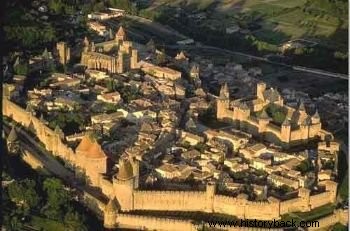The Urban Renaissance represented one of the strands that formed the Renaissance movement, alongside the Cultural and Commercial Renaissance.
It is worth remembering that the Italian Renaissance was an economic, artistic and cultural movement that dominated the European mentality for centuries:from the 14th to the 17th century. Thus, the Urban Renaissance is associated with the flourishing and development of medieval cities, the “Burgos”.
 Medieval City of Carcassonne, France
Medieval City of Carcassonne, France
Historical Context:Summary
In the last period of the Middle Ages, called the Low Middle Ages (10th to 15th century), Europe was going through several transformations in the political, economic and social fields, so that the fall of Constantinople, in 1493, represented the end of the Middle Ages. and the beginning of the Modern Age.
This period was marked by the decadence of the feudal system, basically formed by two social groups:the lords (landowners, the fiefs) and the serfs (they worked and lived in the fiefs). Feudal society was based on status, since it did not have social mobility, that is, if you were born a serf, you will die a serf.
Above the feudal lord were the King, the Nobility and the Clergy, the three groups that held power. In this way, the King represented the supreme power, followed by the nobility (important figures) and the Clergy, associated with the religious power of the Catholic Church.
This last dominant group had clear privileges in relation to the people, so that only they had access to political, economic and religious matters, as well as to the knowledge of books, since they represented the minimum portion that knew how to read and write.
In addition to the demographic explosion arising from the Crusades, which generated a marginalized population that went in search of liberating the Holy Land, and, finally, was left without jobs, land and money, the improvement of agricultural techniques (crop rotation, hydraulic mill, plow , etc.) was one of the important factors for the population growth in the manors, which had a self-sufficient economy (local consumption).
In view of this, the development of European trade routes, from the Crusades (religious, economic and military expeditions that took place between the 11th and 13th centuries) and the intensification of trade, especially in spices in the Mediterranean Sea, made evident the flourishing of the Burgos (small medieval fortified towns), which, previously, were linked to the manor only as religious and military centers where kings, nobles, bishops and some merchants lived.
In this context, some serfs, dissatisfied with the harsh and static conditions of the feudal system, fled (or were expelled by the lord) to the burgos, in search of better living conditions, from free wage labor.
Commercial Renaissance
Note that the Urban Renaissance is closely associated with the Commercial Renaissance, insofar as the growth of boroughs only began to emerge when commerce expanded, from fairs (meetings to carry out commerce).
Learn more about the History and Origin of Fairs.
Thus, the feudal self-sufficient system, based on exchanges (barter), was replaced by commercial relations (sale of products), strengthened by the development of cities and the economic system (emergence of money and banks), insofar as they expanded sources of income and production relations.
Furthermore, the agrarian and estates character of feudalism gave way to urbanization and class structure, with social mobility.
Along with this, the bourgeoisie appears, a new social class committed to acquiring better living conditions through work, formed by merchants, from blacksmiths, tailors, shoemakers, artisans, among others.
Note that the name “bourgeois” and “bourgeoisie” derives from the term “burgs”, since the bourgeois came to be called that because they are the inhabitants of the burgs.
It was in this context of commercial, cultural and urban effervescence that artisans created the “Corporações de Ofício” (organizations that brought together people who exercised the same profession), while merchants established the “Medieval Guilds” (association of people from different professions) and the “Hansas” (traders association), of which the Hanseatic League stands out.
Finally, the “Communal Movement”, demonstrated the struggle of the bourgeois in order to emancipate the villages that still belonged to the feudal lords.
French and Italian cities participated in the confrontation, being called "communes". In this way, little by little, the cities gained their autonomy, putting an end to the rural system of feudalism.
Rebirth - All MatterLearn more about the topic by reading the articles :
- Renaissance:Characteristics and Historical Context
- Characteristics of the Renaissance
- Phases of Rebirth
- Cultural Renaissance
- Artistic Renaissance
- Scientific Renaissance
- Renaissance Humanism
- Formation of National Monarchies
